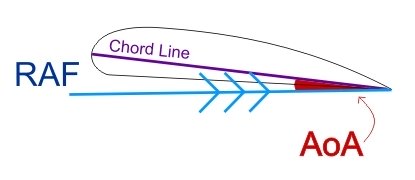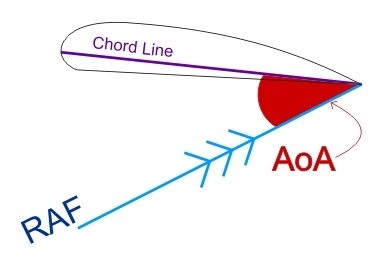Ex 4 : Effects of Controls -
Before you can be expected to understand how the various controls and surfaces affect each other, we need to define the following terms:
Aerofoil section; chord line; camber line; RAF; AoA
Aerofoil section
If you were to slice thorough a wing like this

you would see a wing section like this:

This is a cross sectional view of the wing at this point, called an aerofoil section.
The leading edge is at the front, and the trailing edge is at the back.
Chord line
This is a straight line joining the leading edge to the trailing edge of the aerofoil section.

Mean Camber Line
'Mean' means 'average'.
The camber of the aerofoil is its curvature.
The Mean Camber Line is a line from the leading edge to the trailing edge of the aerofoil section that follows the camber of the aerofoil and cuts it into two equal pieces, top and bottom half.

Relative airflow (RAF)
The relative airflow is direction of undisturbed airflow relative to the aircraft wing. The RAF always flows in the opposite direction to the direction of movement of the aircraft.

Here the aircraft is flying level:

Here it is climbing:

And here it is descending:
Notice how the direction of the relative airflow is opposite to the direction of movement of the aircraft, which is NOT necessarily same as where the aircraft nose is pointing!
This is important to note for when we come to:
Angle of attack
The "angle of attack" (AoA) is the angle between the Chord Line and the Relative Airflow (RAF). See in the examples below how the angle of attack can differ (Top pic CLIMB; middle pic LEVEL; bottom pic DESCENT).
In a climb:
Relatively small angle of attack.
Very close to straight and level.
In level flight:
Notice how the angle of attack in level flight is around 4°. This is the Angle of Incidence, or Rigger's Angle, and provides optimal lift for a minimum drag penalty, which is what we want for the majority of our flight as it will offer both the best economy and performance of our aircraft.
In a descent:
The wing remains almost level (flapless), but the angle of attack increases.
oOo





